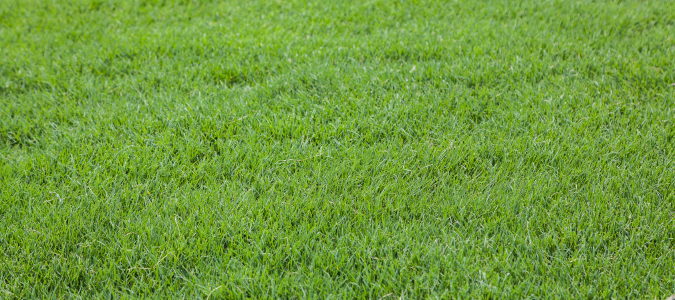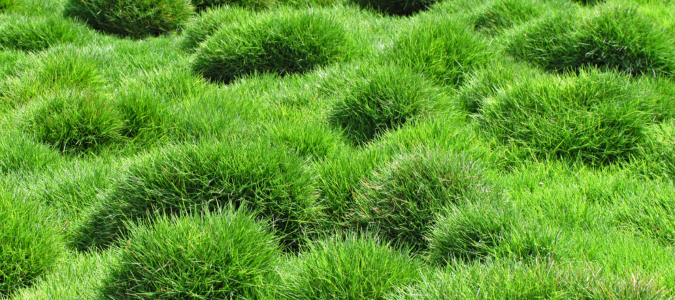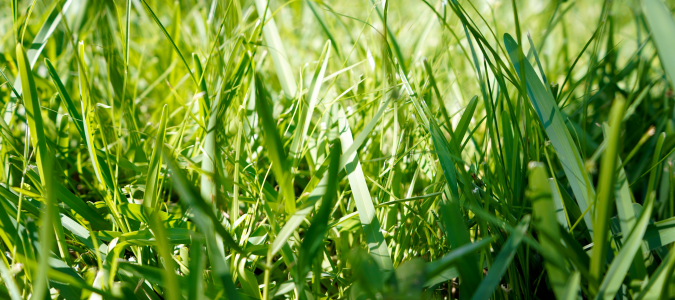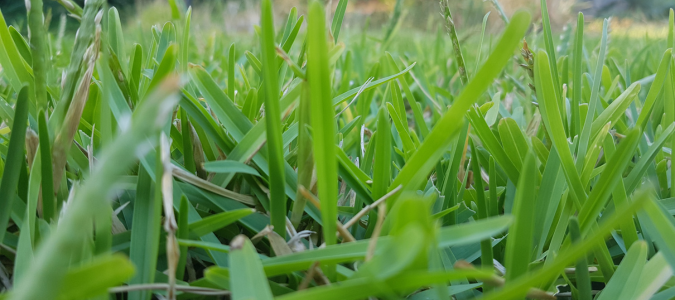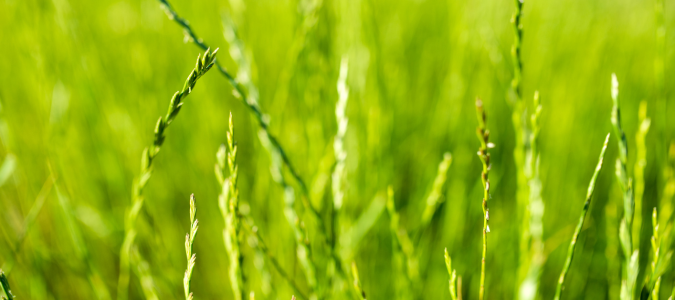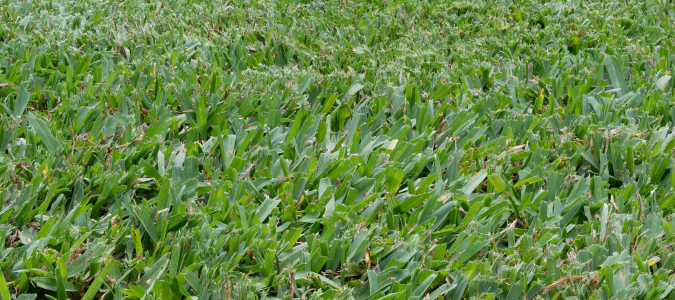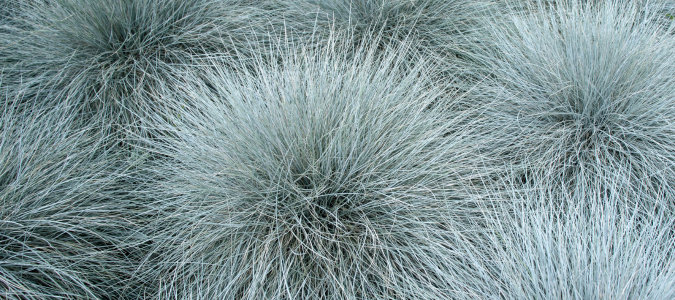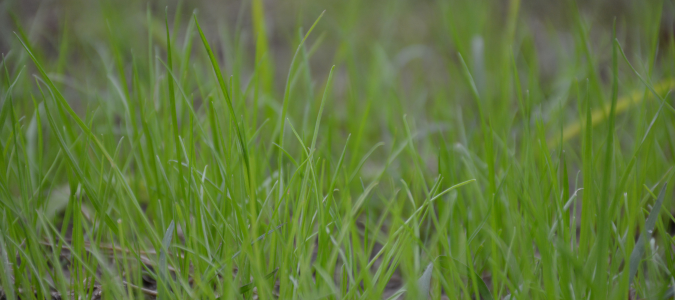Many central Texas homeowners find it difficult to know what type of grass is best for their lawn. While central Texas experiences mild temperatures for most of the year, the summers can reach sweltering levels of heat. It’s important to consider durable warm-season grasses that can withstand drought.
Bermuda Grass
Bermuda grass, pictured above, has a high heat tolerance, which is important when you factor in the warm summers in central Texas. It’s also a grass that can resist drought well.
As a warm-season grass, bermuda grass thrives with well-drained soil and full sun. It’s an excellent choice for high-trafficked areas of your lawn because it grows densely. Its fine texture also makes it a very attractive grass to create a luscious green landscape.
One thing homeowners need to keep in mind when it comes to bermuda grass is that it turns brown and goes dormant in the winter. However, with the right care and maintenance, it will come back healthy and green in the springtime when soil temperatures reach 78 degrees.
There are two primary types of bermuda grass that offer different benefits. Common bermuda is most affordable and offers all of the above mentioned qualities, while a hybrid bermuda grass will have a higher, carpet-like appearance and provide that golf course look when maintained correctly.
Zoysia Grass
Another warm-season grass, zoysia grass thrives in the central Texas heat and dryness. This grass is beloved for its versatility, which makes maintenance a breeze. While zoysia grass thrives in full sun, it is a bit more tolerant of shade.
Additionally, zoysia grass thrives in heat but also has great drought tolerance. Like bermuda grass, zoysia grass has a thin texture. However, the grass blades are a bit wider and they have a smoother feel than bermuda grass blades. One drawback is that zoysia is a slow-grower; therefore, heavily trafficked or damaged areas will result in a slow recovery time.
Another perk of zoysia grass is that it is quite disease-resistant. Overall, it’s a great choice for central Texas that will create a luscious carpet-like lawn. A lawn care professional can help you with common zoysia grass problems you run into.
St. Augustine Grass
Unlike the previous two grasses, St. Augustine grass is a great choice for shaded areas. However, it can still tolerate high heat to survive central Texas summers.
St. Augustine grass requires a bit more maintenance than other grass types, and it is more disease-prone. It thrives with four fertilizations a year, regular watering and mowing. If you do not maintain your St. Augustine grass, it could become susceptible to thatch buildup, fungal diseases and pests like chinch bugs. Similar to zoysia grass, St. Augustine grass has drawbacks when it comes to recovery.
Buffalo Grass
Buffalo grass is an excellent low-maintenance grass. It’s also a great eco-friendly grass choice as it is native to Texas. Buffalo grass is a warm-season grass that thrives in sunny areas, and it doesn’t need as much water as other common types of grass.
Ryegrass
Central Texas may be known for its brutal summer temperatures, but the region can still face some cold fronts. It’s helpful for Texas homeowners to be aware of cold-weather grasses that can still thrive in the winter.
One cool-season grass that thrives in Texas is ryegrass. It is often used as a temporary way to make Texas lawns more green during the fall and winter months when other grasses turn brown. While it won’t last through the Texas heat in the summer, it will keep your lawn looking healthy and green through the winter.
Consult a Lawn Care Professional About Your Lawn
Not sure which grass is right for your central Texas property? The best way to ensure you make the right choice is to consult with a lawn care professional. They can offer expert advice that is personalized to your lawn needs and your desired level of maintenance. The first step to achieving a healthy and vibrant green lawn is to get in touch with a lawn care specialist.
What Does Buffalo Grass Look Like?
Buffalo grass is a warm-season grass that is known for its fine texture, curly grass leaves and vibrant color. The color of buffalo grass can range from light green to blue-green. The grass blades typically grow on the short side, measuring between four and six inches tall.
As a low-growing grass, buffalo grass is an excellent choice for a more manicured look. It has a soft texture that makes it inviting and comfortable to tread on.
Buffalo Grass Benefits
Buffalo grass is a low-maintenance grass choice that has a high tolerance to drought, making it a great grass for central Texas summers. The impressive root system allows buffalo grass to access water deep within the soil, which is helpful for conserving water.
Next, with a slower growth rate, buffalo grass does not require as much mowing as other common grasses. You also don’t have to fertilize it as often, which makes it lower maintenance and more cost-effective than other grass types.
Lastly, as a native Texas grass species, buffalo grass supports the local wildlife and promotes biodiversity.
However, buffalo grass goes dormant in the winter and turns brown, giving your lawn a bleak appearance during the colder months. It is also sensitive to shade, so there are better choices for lawns that have a large amount of tree coverage.
How to Care For Buffalo Grass
Buffalo grass does not need to be watered as often as other grass types. Instead, it requires deep watering to boost root growth.
It also does not require frequent mowing; however, it is a good idea to mow buffalo grass every once in a while during its active growing season in the spring and summer months. To help buffalo grass maintain its natural height, the mower should be set to a higher setting.
Next, buffalo grass does not require frequent fertilization. If you do want to fertilize your buffalo grass, the best practice is to apply a balanced, slow-release fertilizer in the late spring or early summer.
Finally, buffalo grass benefits from aeration in order to help it absorb more water and nutrients. Consult a lawn care professional about how often you should aerate your buffalo grass.
The Differences Between Fescue Versus Ryegrass
Both fescue grass and ryegrass are cool-season grasses that can help keep your lawn looking lush and green throughout the colder months. However, there are key differences between the fescue, pictured above, and ryegrass that homeowners should be aware of if they choose to plant these grasses for a green yard when the weather drops.
Appearance
First, fescue grass has a lush dark green color, a fine texture and medium-thick grass blades. On the other hand, ryegrass is a brighter green color and has a medium texture.
Fescue grass tends to grow in a more uniform pattern than ryegrass, so if you want an immaculate and polished look, fescue grass is a better option.
Use
Ryegrass, pictured above, is a perennial grass that is most often used for overseeding warm-season lawns during the winter months. It is an excellent companion to zoysia or bermuda grasses, both of which go dormant in the winter.
On the flip side, fescue grass does not grow as much during the colder months, and the grass blades may turn yellow in colder temperatures. However, it is a versatile grass that works well in mild climates. Its more uniform look is great for residential lawns.
Needs
Fescue grass thrives with deep watering and well-drained soil. It prefers partial sunlight and needs to be mowed regularly. The blades should be cut to between two and a half and four inches in height. To promote healthy growth, fescue grass should be fertilized in the fall and spring. It is susceptible to disease during high humidity periods.
Ryegrass thrives with regular watering and well-drained soil; however, it can tolerate a variety of soil types. While it prefers full sun, ryegrass can also handle partial shade. It requires frequent mowing and the blades should be cut to one and a half to two and a half inches in length. Ryegrass should also be fertilized in the spring and fall to ensure healthy growth because it is susceptible to disease during highhumidity periods.
Work With a Lawn Care Specialist For the Lawn of Your Dreams
The best way to achieve the green and luscious lawn of your dreams in central Texas is to work with a lawn care specialist. A specialist can create an effective lawn care schedule to keep your lawn green and healthy all year long, even during the colder months.
They can also offer expert advice for your property’s particular needs so that you don’t have to play a guessing game when it comes to your lawn’s health.
ABC Can Take Care of Your Lawn Needs
Figuring out the best lawn care schedule can be tricky. Instead of trying to do it yourself, contact ABC Home & Commercial Services. Our lawn service professionals can handle all the work, so all you have to do is enjoy your time outside.
